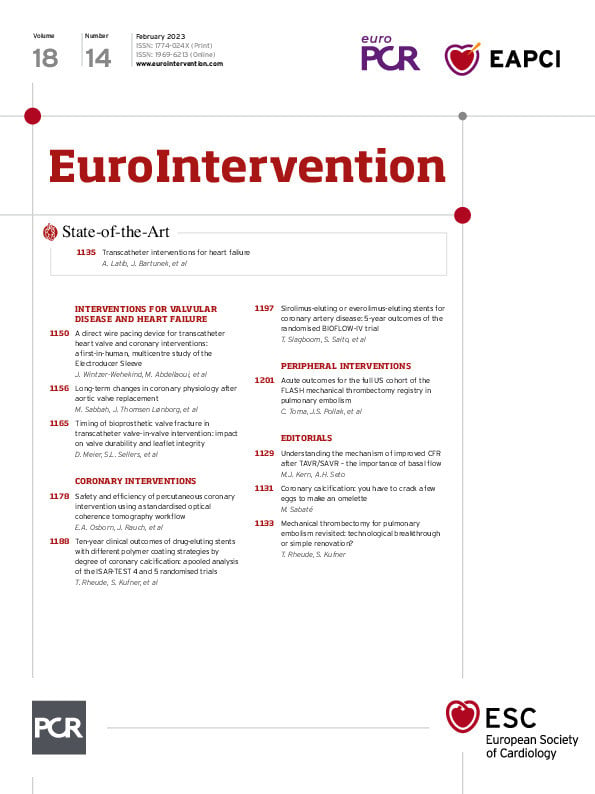Pulmonary embolism (PE) represents the third most frequent cardiovascular cause of death on a global scale, with a slight increase in incidence rates over time1. Current guidelines recommend reperfusion therapy in haemodynamically unstable patients and for those suffering from haemodynamic deterioration despite adequate anticoagulation2. In this regard, systemic thrombolysis has, until recently, been recommended as the first-line treatment of choice23. However, despite being highly effective, its application entails a significantly elevated bleeding risk, with a 9.9% rate of severe bleedings and a 1.7% rate of intracranial haemorrhage4. Therefore, a considerable number of patients do not receive systemic thrombolysis because of an increased bleeding risk or contraindications to thrombolytics.
In recent years, catheter-directed therapies (CDT) have been increasingly used for primary mechanical reperfusion, which is paralleled by the growing scientific attention in these therapies2. Several catheter-directed reperfusion techniques, including thrombus fragmentation, mechanical embolectomy and local (ultrasound-accelerated) catheter-directed thrombolysis have become available5. However, robust data regarding the clinical efficacy and potential harm of these technologies remain scarce, and results from adequately powered trials are warranted.
In this issue of EuroIntervention, Toma et al report acute outcomes from the FlowTriever All-Comer Registry for Patient Safety and Hemodynamics (FLASH) study6. This prospective single-arm study included 799 patients across 50 US sites with high-risk (7.9%) and intermediate-risk (92.1%) PE treated with mechanical thrombectomy using the FlowTriever system (Inari Medical). Of note, one-third of patients had thrombolytic contraindications. The primary safety endpoint was major adverse events (MAE) within 48 hours of the procedure, defined as a composite of device-related death, major bleeding or intra-procedural adverse events. Secondary effectiveness endpoints included haemodynamic and functional parameters, such as the echocardiographic right ventricle (RV)/left ventricle (LV) ratio, systolic pulmonary artery pressure (sPAP), total pulmonary vascular resistance (TPVR) and dyspnoea improvement. All-cause mortality was 0.3% at 48 hours, with no device-related deaths, and MAE occurred in 1.8% of patients, mainly driven by major bleedings. Immediately after mechanical thrombectomy, the following parameters decreased significantly: the RV/LV ratio (from 1.23 to 0.98; p<0.0001), sPAP (from 53.2 to 40.4 mmHg; p<0.0001), TPVR (from 6.65 to 4.99 mmHg*min/L; p<0.0001) and heart rate (from 102 to 90 bpm; p<0.0001).
As current evidence regarding CDT is limited, Toma and colleagues are to be commended on their effort to gather the largest cohort of PE patients undergoing interventional treatment to date with the following caveats. Firstly, despite being an all-comers registry, the applicability of the results to a general PE population is limited by the fact that patients were deemed eligible for mechanical thrombectomy at the discretion of the treating physician without prespecified inclusion criteria. As routine use of CDT is not justified by current guideline recommendations as an alternative to systemic thrombolysis (class IIa recommendation, level of evidence C), appropriate patient selection for interventional treatment remains crucial; this central question remains unanswered in the current trial. Secondly, although the 30-day mortality rates of <1% are encouraging, especially as the majority of patients being categorised with more than intermediate risk with a simplified pulmonary embolism severity index (sPESI) ≥1 in 84% and positive cardiac biomarkers in 95% of patients7, comparisons across studies regarding mortality rates should be taken with caution. In this regard, the possibility of post-procedural consent might have introduced further selection bias. Thirdly, an immediate effect of mechanical thrombectomy was postulated because of a significant decrease in the mean RV/LV ratio, sPAP, TPVR and heart rate. These beneficial results with regard to surrogate parameters − especially the RV/LV ratio, which has become the standard to evaluate CDT effectiveness − confirm previous study results with other devices89. Nevertheless, additional prospective trials are needed to confirm that surrogate parameters translate into improved clinical outcomes and that mechanical reperfusion changes the detrimental course of disease. An improvement of self-reported dyspnoea and a decrease of supplemental oxygen requirements following thrombectomy were reported by the authors and support the potency of CDT.
Overall, the FLASH study adds an important piece of puzzle to the growing body of evidence in the (interventional) treatment of this potentially fatal disease condition. Currently, there are several ongoing randomised trials that compare different CDT to either each other, anticoagulation alone or systemic thrombolysis5. In the meanwhile, the indications for CDT should be based on an individualised patient assessment taking comorbidities, bleeding risk and local expertise into consideration.
Conflict of interest statement
T. Rheude received speaker fees from AstraZeneca and SIS Medical, not related to the current work. S. Kufner received speaker and consulting fees from AstraZeneca, Bristol-Myers Squibb, Translumina, and Bentley, not related to the current work.

